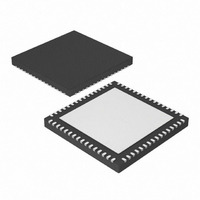PIC24FJ256GB106-I/MR Microchip Technology, PIC24FJ256GB106-I/MR Datasheet - Page 127

PIC24FJ256GB106-I/MR
Manufacturer Part Number
PIC24FJ256GB106-I/MR
Description
IC, 16BIT MCU, PIC24F, 32MHZ, QFN-64
Manufacturer
Microchip Technology
Series
PIC® 24Fr
Datasheets
1.PIC24FJ128GA106-IPT.pdf
(52 pages)
2.PIC24FJ64GB106-IPT.pdf
(16 pages)
3.PIC24FJ64GB106-IPT.pdf
(352 pages)
4.PIC24FJ192GB108-IPT.pdf
(328 pages)
Specifications of PIC24FJ256GB106-I/MR
Controller Family/series
PIC24
No. Of I/o's
51
Ram Memory Size
16KB
Cpu Speed
32MHz
No. Of Timers
5
Core Size
16 Bit
Program Memory Size
256KB
Peripherals
ADC, Comparator, PWM, RTC, Timer
Core Processor
PIC
Speed
32MHz
Connectivity
I²C, SPI, UART/USART, USB OTG
Number Of I /o
51
Program Memory Type
FLASH
Ram Size
16K x 8
Voltage - Supply (vcc/vdd)
2 V ~ 3.6 V
Data Converters
A/D 16x10b
Oscillator Type
Internal
Operating Temperature
-40°C ~ 85°C
Package / Case
64-VFQFN, Exposed Pad
Processor Series
PIC24FJ
Core
PIC
Data Bus Width
16 bit
Data Ram Size
16 KB
Interface Type
I2C, SPI, UART
Maximum Clock Frequency
32 MHz
Number Of Programmable I/os
52
Number Of Timers
5
Maximum Operating Temperature
+ 85 C
Mounting Style
SMD/SMT
3rd Party Development Tools
52713-733, 52714-737, 53276-922, EWDSPIC
Development Tools By Supplier
PG164130, DV164035, DV244005, DV164005, PG164120, DM240001, DM240011
Minimum Operating Temperature
- 40 C
On-chip Adc
10 bit, 16 Channel
Lead Free Status / RoHS Status
Lead free / RoHS Compliant
For Use With
876-1004 - PIC24 BREAKOUT BOARD
Eeprom Size
-
Lead Free Status / Rohs Status
Details
Available stocks
Company
Part Number
Manufacturer
Quantity
Price
Company:
Part Number:
PIC24FJ256GB106-I/MR
Manufacturer:
TI
Quantity:
1 292
- PIC24FJ128GA106-IPT PDF datasheet
- PIC24FJ64GB106-IPT PDF datasheet #2
- PIC24FJ64GB106-IPT PDF datasheet #3
- PIC24FJ192GB108-IPT PDF datasheet #4
- Current page: 127 of 352
- Download datasheet (3Mb)
8.4.2
At a minimum, performing a clock switch requires this
basic sequence:
1.
2.
3.
4.
5.
Once the basic sequence is completed, the system
clock hardware responds automatically as follows:
1.
2.
3.
4.
5.
6.
2009 Microchip Technology Inc.
Note 1: The processor will continue to execute
If
(OSCCON<14:12>) to determine the current
oscillator source.
Perform the unlock sequence to allow a write to
the OSCCON register high byte.
Write the appropriate value to the NOSCx bits
(OSCCON<10:8>) for the new oscillator source.
Perform the unlock sequence to allow a write to
the OSCCON register low byte.
Set the OSWEN bit to initiate the oscillator
switch.
The clock switching hardware compares the
COSCx bits with the new value of the NOSCx
bits. If they are the same, then the clock switch
is a redundant operation. In this case, the
OSWEN bit is cleared automatically and the
clock switch is aborted.
If a valid clock switch has been initiated, the
LOCK (OSCCON<5>) and CF (OSCCON<3>)
bits are cleared.
The new oscillator is turned on by the hardware if
it is not currently running. If a crystal oscillator
must be turned on, the hardware will wait until the
Oscillator Start-up Timer (OST) expires. If the
new source is using the PLL, then the hardware
waits until a PLL lock is detected (LOCK = 1).
The hardware waits for 10 clock cycles from the
new clock source and then performs the clock
switch.
The hardware clears the OSWEN bit to indicate a
successful clock transition. In addition, the
NOSCx bit values are transferred to the COSCx
bits.
The old clock source is turned off at this time,
with the exception of LPRC (if WDT or FSCM is
enabled) or SOSC (if SOSCEN remains set).
2: Direct clock switches between any
desired,
OSCILLATOR SWITCHING
SEQUENCE
code throughout the clock switching
sequence. Timing-sensitive code should
not be executed during this time.
Primary Oscillator mode with PLL and
FRCPLL mode are not permitted. This
applies to clock switches in either direc-
tion. In these instances, the application
must switch to FRC mode as a transition
clock source between the two PLL
modes.
read
the
COSCx
PIC24FJ256GB110 FAMILY
bits
A recommended code sequence for a clock switch
includes the following:
1.
2.
3.
4.
5.
6.
7.
8.
The core sequence for unlocking the OSCCON register
and initiating a clock switch is shown in Example 8-1.
EXAMPLE 8-1:
;Place the new oscillator selection in W0
;OSCCONH (high byte) Unlock Sequence
MOV
MOV
MOV
MOV.b
MOV.b
;Set new oscillator selection
MOV.b
;OSCCONL (low byte) unlock sequence
MOV
MOV
MOV
MOV.b
MOV.b
;Start oscillator switch operation
BSET
Disable interrupts during the OSCCON register
unlock and write sequence.
Execute the unlock sequence for the OSCCON
high byte by writing 78h and
OSCCON<15:8>
instructions.
Write new oscillator source to the NOSCx bits in
the instruction immediately following the unlock
sequence.
Execute the unlock sequence for the OSCCON
low
OSCCON<7:0> in two back-to-back instructions.
Set the OSWEN bit in the instruction immediately
following the unlock sequence.
Continue to execute code that is not clock-sensitive
(optional).
Invoke an appropriate amount of software delay
(cycle counting) to allow the selected oscillator
and/or PLL to start and stabilize.
Check to see if OSWEN is ‘0’. If it is, the switch
was successful. If OSWEN is still set, then
check the LOCK bit to determine the cause of
the failure.
byte
#OSCCONH, w1
#0x78, w2
#0x9A, w3
w2, [w1]
w3, [w1]
WREG, OSCCONH
#OSCCONL, w1
#0x46, w2
#0x57, w3
w2, [w1]
w3, [w1]
OSCCON,#0
by
writing
BASIC CODE SEQUENCE
FOR CLOCK SWITCHING
in
46h
two
DS39897C-page 127
and
back-to-back
9Ah to
57h
to
Related parts for PIC24FJ256GB106-I/MR
Image
Part Number
Description
Manufacturer
Datasheet
Request
R

Part Number:
Description:
Manufacturer:
Microchip Technology Inc.
Datasheet:

Part Number:
Description:
Manufacturer:
Microchip Technology Inc.
Datasheet:

Part Number:
Description:
Manufacturer:
Microchip Technology Inc.
Datasheet:

Part Number:
Description:
Manufacturer:
Microchip Technology Inc.
Datasheet:

Part Number:
Description:
Manufacturer:
Microchip Technology Inc.
Datasheet:

Part Number:
Description:
Manufacturer:
Microchip Technology Inc.
Datasheet:

Part Number:
Description:
Manufacturer:
Microchip Technology Inc.
Datasheet:

Part Number:
Description:
Manufacturer:
Microchip Technology Inc.
Datasheet:











